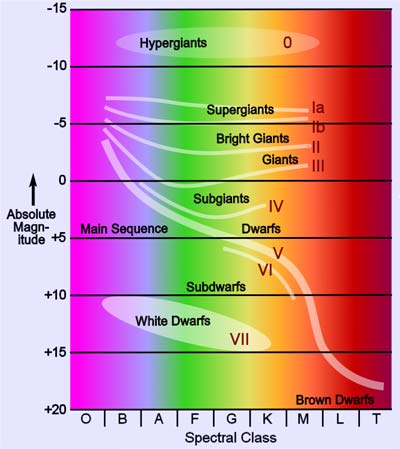.
Hypergiant
A hypergiant (luminosity class 0) is a star with tremendous mass and luminosity.
Characteristics

Hertzsprung-Russell diagram (*) |
Hypergiants are more massive than supergiants, stars which have masses up to 100 times that of the Sun. Hypergiants are not necessarily larger (in terms of volume) than supergiants, but are usually more massive. This approaches the Eddington limit, a theoretical upper limit of stellar mass (about 120 solar masses) at which a star generates so much radiation that it throws off its outer layers. Some hypergiants appear to be more than 100 solar masses and may have initially been 200 to 250 solar masses, challenging current theories of star formation and stellar evolution.
Hypergiants are the most luminous stars, thousands to millions of solar luminosities; however, their temperatures vary widely between 3,500 K and 35,000 K. Almost all hypergiants exhibit variations in luminosity over time due to instabilities within their interiors at moderate temperatures and high pressures.
Hypergiants should not be confused with luminous blue variables. A hypergiant is classified as such because of its size alone, and can have smaller masses. A luminous blue variable is determined by being the initial stage of a very massive star.

Size comparison between the Sun and VY Canis Majoris, a hypergiant which is the largest known star.
Known hypergiants
Hypergiants are difficult to study due to their rarity. There appears to be an upper luminosity limit for the coolest hypergiants (those colored yellow and red): none of them are brighter than around bolometric magnitude -9.5, which corresponds to roughly 500,000 times Sun's luminosity. The reasons for that are currently unknown.
Luminous blue variables
Most luminous blue variables are classified as hypergiants, and indeed they are the most luminous stars known:
* P Cygni, in the northern constellation of Cygnus.
* S Doradus, in a nearby galaxy called the Large Magellanic Cloud, in the southern constellation of Dorado. This galaxy was also the location of Supernova 1987A.
* Eta Carinae, inside the Keyhole Nebula (NGC 3372) in the southern constellation of Carina. Eta Carinae is extremely massive, possibly as much as 120 to 150 times the mass of the Sun, and is four to five million times as luminous.
* The Pistol Star, near the center of the Milky Way, in the constellation of Sagittarius. The Pistol Star is possibly as much as 150 times more massive than the Sun, and is about 1.7 million times more luminous.
* Several stars in the cluster 1806-20, on the other side of the Milky Way galaxy. One such star, LBV 1806-20, is the most luminous star known, from 2 to 40 million times as luminous as the Sun, and also one of the most massive.
Blue hypergiants
* Zeta-1 Scorpii, the brightest star of the OB association Scorpius OB1 and a LBV candidate.
* MWC 314, in the constellation of Aquila, another LBV candidate.
* HD 169454, in Scutum
* BD -14° 5037 near of the latter.
* Cygnus OB2 #12, which some authors consider an LBV.
Yellow hypergiants
Yellow hypergiants form an extremely rare class of stars, with only seven being known in our galaxy:
* Rho Cassiopeiae, in the northern constellation of Cassiopeia, is about 500,000 times as luminous as the Sun.
* HR 8752
* IRC+10420
* Also see stars in Westerlund 1.
Red hypergiants
* RW Cephei
* NML Cygni
* VX Sagittarii
* S Persei
* VY Canis Majoris has the largest diameter of any known star, 1800 to 2100 times that of the Sun.
See also
Retrieved from "http://en.wikipedia.org/"
All text is available under the terms of the GNU Free Documentation License

